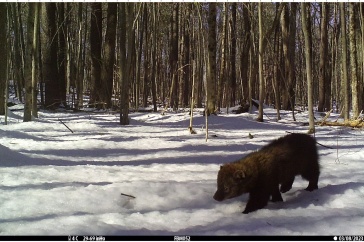A CO2 Sensor for Lotic (Moving) Water, Including Streams and Rivers

Images from left to right: 1) Diagram showing cross section of sensor and sensor components; 2) Photo of sensor attached to floating apparatus, which allows for vertical up and down movement to account for changes in water level; and 3) Photo showing submerged portion of sensor with copper tape coating designed to limit damage from microorganisms.
Key Research Finding
Modifications made to an existing open-source carbon dioxide (CO2) sensor allows researchers to more efficiently collect CO2 concentration data from moving bodies of water, such as streams and rivers, and better understand the role that they play in carbon cycling and global carbon dioxide emissions.
Key Terms
High-frequency monitoring: Refers to the process of taking frequent, repeated measurements over an extended time to obtain a better picture of measurement fluctuations. In contrast, point sampling allows researchers to calculate long-term.
Lotic ecosystems: An ecosystem containing moving water, such as rivers, streams, and springs.
pCO2: Partial pressure of carbon dioxide, or pCO2, is used within climate science, hydrology, and similar fields to indicate the CO2 concentration in water or precipitation.
Carbon dioxide (CO2) emissions are not typically associated with water ways, but emerging research shows that water bodies play an important role in storing and releasing carbon dioxide. As New Hampshire embarks on updating its state climate action plan, accurately understanding the potential impacts of the Granite State’s more than 19,000 miles of rivers and streams is essential to developing cost-effective climate change mitigation goals and policies. Recent research by scientists with the New Hampshire Agricultural Experiment Station centers on optimizing existing CO2 sensors to measure carbon dioxide emissions in lotic, or moving, water systems, offering a tool that can help inform New Hampshire’s climate action plan.
Station scientist Wil Wollheim, an associate professor with the UNH College of Life Sciences and Agriculture (COLSA), and Andrew Robison '21G described their innovations in a co-authored paper in Limnology and Oceanography: Methods. In addition to being able to accurately measure CO2 levels in streams and rivers, the researchers wanted to significantly increase the frequency at which emissions could be captured, helping to better understand the impacts of extreme precipitation events and other periods when there are disruptions to historically observed water flow rates.
“These sensors, adapted for the highly dynamic flow—think floods, allow us to see if a disproportionate amount of CO2 is transferred from land during short periods of time, and whether this contributes significant emissions to the atmosphere,” explained Wollheim.
“We are in the midst of a revolution in environmental measurements...The more we can deploy and, critically, maintain such sensor measurements, the more we will learn how to sustain a healthy environment.” ~ Wil Wollheim, professor of Natural Resources and the Environment
Wollheim, Robison, and collaborators in COLSA and the UNH Institute for the Study of Earth modified an existing sensor—developed to measure dissolved carbon dioxide in oceans—by adding a protective housing that accounted for changing water levels and unidirectional flow of running water. The researchers also chose materials known to limit damage to the sensor by microorganisms. The team plans to make these sensor modifications publicly available, allowing other scientists to use the design.
“After making these adaptations, we found the sensors to be quite reliable in measuring pCO2 in streams,” said Robison. “We were able to differentiate between streams that were bigger sources of CO2 and start to examine when and why moments of high CO2 emissions occurred.”
Robison added, “One area of research we are particularly interested in is how land use change alters the CO2 regimes of streams and rivers. If we develop land from a forest into a farm or a suburban neighborhood, how will the CO2 patterns change? These sensors will help us understand the mechanism of these changes, such as altering stream metabolism or the runoff dynamics.”
Already, Wollheim has begun related sensor modification projects to measure CO2 in other environments, including forests and agricultural lands. These sensors will focus on soil characteristics, potentially providing farmers and other land managers with almost real-time information for optimizing soil nutrients to support their farming operations and minimizing excess fertilizer applications that could lead to runoff and surplus nutrients in New Hampshire’s lakes, ponds and other water bodies.
“We are in the midst of a revolution in environmental measurements,” says Wollheim. “The more we can deploy and, critically, maintain such sensor measurements, the more we will learn how to sustain a healthy environment.”
This material is based on work supported by the NH Agricultural Experiment Station through joint funding from the USDA National Institute of Food and Agriculture (under Hatch award numbers 0225006 and 1019522) and the state of New Hampshire. Funding was also provided by the UNH Natural Resources and Earth Systems Science program, by the NSF Established Program to Stimulate Competitive Research (EPSCoR 1101245) and through the following grants: PIE-LTER OCE-1637630, EF-1926423, EF-1926591, NSF SRS 2215300 and GRFP-623 0913620.
This work is co-authored by Andrew Robison, Lauren Koenig, Jody Potter, Lisle Snyder, Christopher Hunt, William McDowell and Wilfred Wollheim.
-
Written By:
Maeve Gifford | UNH College of Life Sciences and Agriculture | Maeve.Gifford@unh.edu

















































